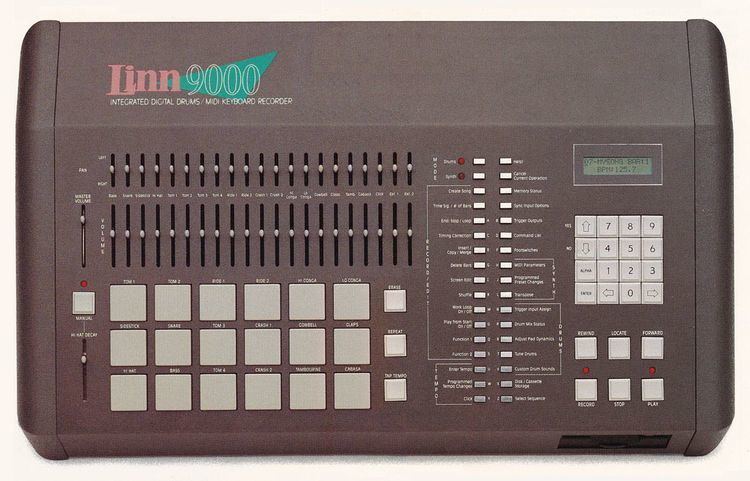Manufacturer Linn Electronics Polyphony polyphonic 13 voices | Dates 1984-1986 Timbrality multitimbral 18 voices | |
 | ||
Price US $5,000 ($7,000 fully expanded) Synthesis type 8 bit Digital Samples / 11 kHz - 37kHz | ||
The Linn 9000 is an electronic musical instrument manufactured by Linn Electronics as the successor to the LinnDrum. It was introduced in 1984 at a list price of $5,000, ($7,000 fully expanded) and about 1100 units were produced.
Contents
It combined MIDI sequencing and audio sampling (optional) with a set of 18 velocity and pressure sensitive performance pads, to produce an instrument optimized for use as a drum machine. It featured programmable hi-hat decay, 18 digital drum sounds, a mixer section, 18 individual 1/4" outputs, an LCD display, 6 external trigger inputs and an internal floppy disk drive (optional). The Linn 9000 had innovative and groundbreaking features and would influence many future drum machine designs. But chronic software bugs led to a reputation for unreliability and contributed to the eventual demise of Linn Electronics.
The Linn 9000 would get a new lease on life when Forat Music and Electronics purchased Linn's remaining assets, fixed all of the bugs, added new features and dubbed it the Forat F9000.
History
The Linn 9000 would be Roger Linn's first attempt to create an integrated sampling/sequencing/MIDI work station. He would draw heavily on the Linn 9000 and the Sequential Circuits Inc. Studio 440 when he designed the Akai MPC60, released in 1988.
The Linn 9000 was plagued with problems from the beginning.
On early models, the power supply over-heated the CPU and had to be replaced under warranty. The original Linn 9000 operating system was mostly written in an esoteric high-level programming language called FORTH with some machine language. In early versions, some of the FORTH code produced unacceptable delays in user interface functions and was rewritten in machine language. But the operating system had numerous bugs and it was common for the machine to lock-up and lose data.
Linn attempted to debug, rewrite and enhance the operating system. But the 64K code space memory segmentation in the Intel 8088 was perceived as an insurmountable limitation on memory that left no room for new features. Further software development was abandoned.
The flawed Linn 9000 operating system was also used in the LinnSequencer, a rack mount 32 track hardware MIDI sequencer introduced by Linn Electronics in 1985. As a result, both machines earned a reputation for being notoriously unreliable. In addition, the same operating system was used in the LinnDrum Midistudio, a rack mount version of the Linn 9000 that was planned to be the successor to the 9000, but was never released.
These issues contributed to the eventual demise of Linn Electronics in 1986. Forat Music and Electronics purchased Linn's remaining assets, completely reinvented the Linn 9000, fixed all of the bugs and dubbed it the Forat F9000; released in 1987.
Features
The Linn 9000 has eighteen 8 bit 11 kHz ~ 37 kHz digitally sampled drum sounds: bass, snare, sidestick, hihat, two crash cymbals, two ride cymbals, four toms, cabasa, tambourine, high and low congas, cowbell and clap.
The Linn 9000 had many firsts.
In addition to being the first drum machine to incorporate a MIDI sequencer, it was the first drum machine with custom sounds, sampling capability (optional), a floppy disk drive (optional) and an LCD display.
The programmable hi-hat decay is a unique feature that provides seven open hi-hat positions in addition to the closed hi-hat, allowing for subtle and expressive performances.
The Linn 9000's most distinctive feature was 18 large (1.25 inch square) velocity and pressure sensitive rubber pads. Pad pressure is used for the Note Repeat feature. If you hold Timing Correction and apply continuous pressure to a pad while in record mode, that note is automatically repeated at the Timing Correction note value setting. The velocity (volume) level of each repeated note is determined by the amount of pressure applied at the time the note is played. Similar rubber pads would be seen on many subsequent drum machines and controllers including the Akai MPC60 and the Akai MPC4000.
Standard Features
Optional Features
Architecture
The Linn 9000 circuitry is deployed as a mother board with 14 slots. Daughter boards are used to deploy standard and optional features, with slots on the back panel resembling PCs of the time. It uses the Intel 8088 CPU chip.
